|
|
| |
|
|
| |
|
|
|
|
| |
 Travel
America Travel
America
Learn before you travel. This section of Fun Easy
English focuses on facts and other cool stuff about
your favorite U.S. state. This is great English
reading practice. This page focuses on the state of
New Jersey. |
 Hey
if you cannot understand something on this page, Hey
if you cannot understand something on this page,
then use the Fun Easy English
dictionary
(opens in a new window) |
|
|
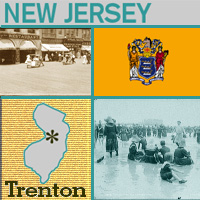 New
Jersey New
Jersey
Italian Giovanni da Verrazano, in 1524, was the
first European to explore the area we know today as
New Jersey. One of the original 13 states (it joined
the Union in 1787), it was named after the island of
Jersey in the English Channel. New Jersey is
referred to as the "Garden State" because of its
fertile farmland. General George Washington won a
key Revolutionary War battle at Trenton when he
crossed the Delaware River from Pennsylvania and
surprised the Hessian soldiers stationed there.
Trenton is the state capital, and the flower is the
purple violet. "Atlantic City, a resort town and
former home to the Miss America pageant, attracts
visitors from around the world." |
|
New Jersey
State Flag
In 1780, during the Revolutionary war, General
George Washington directed that the regiments of the New
Jersey Continental Line have a flag of dark blue and buff
(buff and Jersey blue are now recognized as the official
state colors of New Jersey).
General Washington presumably selected these colors for
historic reasons; New York and New Jersey were both
originally settled by the Dutch, and dark blue (Jersey blue)
and buff were Holland's (the Netherlands) insignia. The
center of the flag features New Jersey's coat of arms
(featured on the great seal of New Jersey).
Symbols on New Jersey's Coat of Arms
Three plows on the shield honor the state's agricultural
tradition. The helmet above the shield faces forward, an
attitude denoting sovereignty (fitting for one of the first
governments created under the notion that the state itself
is the sovereign). The crest above the helmet is a horse's
head (the horse is also New Jersey's official state animal).
The supporting female figures are Liberty and Ceres (Roman
goddess of grain - a symbol of abundance). Liberty carries
the liberty cap on her staff and Ceres holds a cornucopia
filled with harvested produce; they are supported by a
banner that reads "Liberty and Prosperity" (New Jersey's
state motto). |
|
Source:
State Symbols USA |
|
|
 New Jersey
State Facts New Jersey
State Facts
Picture: state seal of New Jersey |
|
State Capital |
Trenton |
|
Nickname |
Garden State |
|
Motto |
Liberty and Prosperity |
|
Statehood |
December 18, 1787 (3rd) |
|
Origin of Name |
Named for the Channel Island of Jersey in honor of
Sir George Carteret, one of the two men to whom the
land was given |
|
Largest Cities |
Newark, Jersey City, Paterson, Elizabeth, Trenton |
|
Border States |
Delaware, New York, Pennsylvania |
|
Area |
7,419 sq. mi., 46th largest |
|
State Bird |
Eastern Goldfinch |
|
State Flower |
Violet (viola sororia) |
|
State Tree |
Red Oak (quercus borealis maxima) |
|
State Song |
None |
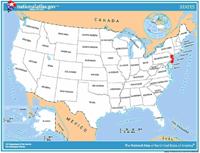 Travel and tourism
site for New Jersey - This state travel and territorial
tourism site provides ideas for your vacations, meetings, and more. Travel and tourism
site for New Jersey - This state travel and territorial
tourism site provides ideas for your vacations, meetings, and more. |
|
|
New Jersey Stories |
|
|
The Marlboro Tree
How old do trees live to be? There is a black willow tree in
Marlboro, New Jersey, that is more than 150 years old. It started
growing before the Civil War. Not only is the Marlboro Tree old, but
it's also huge. It's 76 feet tall and over 19 feet in circumference
(the measurement around the trunk of the tree). Five adults would
have to hold hands to fully encircle the trunk. The Marlboro Tree is
the largest black willow in New Jersey and the largest tree in
Marlboro. In fact, the New Jersey Forest Service has certified it as
a "State Champion" because of its size.
Black willow trees usually grow along lakes and streams, where they
help prevent erosion (the wearing away of soil by water). Black
willows have blackish-colored bark and are known to have several
trunks on one tree. The wood of the tree is light and flexible, so
it is often used to make artificial limbs, wicker baskets and
furniture.
The Marlboro Tree is also special because it grows in an area where
many dinosaur fossils have been found. Because of its unique
history, the town has made a special effort to preserve the Marlboro
Tree for future generations to enjoy. |
|
|
Clean Ocean Action's Beach Sweep
Have you ever been part of a volunteer clean-up crew, picking up
litter or trash? If so, you know just how much garbage can collect
on streets or in parks. In New Jersey there was another place that
had a lot of litter -- the beaches.
By the 1980s, thanks to ocean dumpsites and runoff water, pollution
was ruining New Jersey's beaches. Runoff water, which is often
polluted, flows into streams and ends up in the ocean.
To help clean up New Jersey's polluted beaches, a group called Clean
Ocean Action holds Beach Sweeps. One of the longest running cleanups
in the world, the Beach Sweeps first started in 1985 at Sandy Hook
with 75 volunteers. Today, volunteers of all ages "sweep" the
beaches by picking up garbage and other debris and writing down what
they collect. The list of litter provides information that is used
to educate the public about the pollution problem.
Volunteers usually pick up plastic, glass, metal, wood, and
styrofoam. They have also collected some unusual items from the
beaches, such as a shopping cart, a microwave oven, a toilet,
mattresses, Christmas decorations, and a wig! Keeping a list of
items helps people realize that garbage can come back to us if we
don't dispose of it properly. |
|
|
Walking the Boardwalk in Atlantic City
Have you ever played Monopoly? Did you know that the game's most
expensive property, Boardwalk, comes from an actual place in New
Jersey, called Atlantic City?
The pleasant climate and beaches of Atlantic City had already made
it a popular resort destination for New Yorkers by the time the
first section of its famous boardwalk was constructed along the
beach in 1870. Alexander Boardman, a railroad conductor, thought of
the idea of constructing a boardwalk to keep sand out of the
railroad cars and hotels. The city used its tax revenues to build an
8-foot-wide temporary wooden walkway, which could be taken down
during the winter. The walkway was later extended and made
permanent. The rolling chair, introduced in 1884, was the only
vehicle allowed on the boardwalk. Guests could be rolled down the
boardwalk while sitting down. |
|
|
Liberty Science Center "Camp-Ins" Program
Why is this girl's hair standing on end? It is this way because of
static electricity.
Everything is made up of millions of tiny particles, called atoms.
Inside atoms are protons and electrons, which have positive and
negative electric charges. When you rub two things together, some of
the negative charges, or electrons, move from one surface to the
other. The object that loses electrons becomes positively charged,
and the one that gains electrons becomes negatively charged.
Opposites (positive and negative) attract, so the objects pull
together. This is static electricity.
Objects with the same charge push away from each other. When the
girl in the photo touches the ball with static electricity inside
it, it sends a static charge through her body and into each strand
of hair. Because each strand has the same charge, the strands push
away from each other, so her hair stands up. (This experiment was
done in the safety of a museum; it is not something to try anyplace
else.)
Experiments like these are best attempted in a museum. The girls in
the photograph are visiting the Liberty Science Center in New
Jersey. Several times a year, the center holds a "Camp-In," where
groups of kids have fun with the science exhibits until late at
night, and then they sleep over in the museum. |
|
|
The Battle of Monmouth
Her name was Mary Hays McCauly, but she was better known as Molly
Pitcher. Do you know who she was? Or how she got her name?
Mary Hays was the wife of William Hays, an artilleryman who fought
in the Battle of Monmouth during the Revolutionary War.
The battle began as General Henry Clinton led his British forces
from Philadelphia and started marching through New Jersey. On the
morning of June 28, 1778, a scorching hot day, General George
Washington ordered General Charles Lee to attack the British near
Monmouth, New Jersey. The British and American armies fought all day
in the intense heat.
Dodging the bullets was Mary Hays, who brought pitcher after pitcher
of water to the thirsty troops. She also assisted the injured
troops. When her husband fell in battle, she took his place at the
cannon. This was the second time on an American battlefield that a
woman had worked a cannon. (The first was Margaret Corbin during the
defense of Fort Washington in 1776.)
For her heroic role, General Washington made her a noncommissioned
officer. After that she was widely known as "Sergeant Molly." A
sculpture on the battle monument commemorates her courageous
efforts. |
|
|
The Irish of the Fifth District
Leprechauns, shamrocks, St. Patrick's Day, and jigs -- these are the
things we usually think of first when it comes to Irish traditions.
But did you know that bagpipe bands are also a big part of Irish
culture? The boy in the photo is part of the Bergen pipe band in
Bergen County, New Jersey.
A pipe band is a traditional Scottish or Irish musical group of
bagpipers and drummers. A bagpipe is a wind instrument that gets its
air supply through a bag. Every member of a pipe band wears a kilt,
a knee-length tartan, or plaid skirt, traditionally worn by Scottish
or Irish men.
Pipe bands are a tradition for Irish Americans in New Jersey. The
Irish are the second largest ethnic group in this state. Their
ancestors came in large numbers, especially during the 19th century.
Pipe bands are one way Irish Americans in New Jersey keep their
culture alive. |
|
|
The Still Family
You may not know it, but there is royalty in America. Although we
don't honor royalty as people in other countries do, the Still
family, which has been in New Jersey since the early 1600s, is
descended from a Guinean prince from Africa. The prince and his
people intermarried with the Lenape Indians, who lived in the area.
Before the Civil War, the Still family was active in the
anti-slavery movement. At the time, many slaves in the South escaped
through the Underground Railroad. The Underground Railroad was made
up of a network of people who secretly helped slaves escape to the
Northern states or Canada. While many white Americans were a part of
the Underground Railroad, free blacks gave the most assistance to
runaway slaves. The Still family hometown, Lawnside, New Jersey, was
a stop on the Underground Railroad. Two members of the Still family,
William and James Still, were conductors -- people who helped out
along the way.
In 1872 William Still wrote the classic book The Underground
Railroad about the heroism of the runaway slaves, many of who
stopped at his house on their way to freedom, and the people who
helped them escape. If you want to learn more about the people on
the Underground Railroad, this would be a good book to read. |
|
Source:
Library of Congress |
|
 National Monuments of New Jersey National Monuments of New Jersey
The following is a description of national monuments in the state
of New Jersey. There are no national forests
or parks in this state. If you plan to visit or live
in New Jersey for awhile then you should
definitely plan to visit some of these
fantastic places. |
|
|
|
National Monuments |
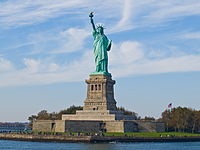 Statue
of Liberty Statue
of Liberty
This iconic statue, built in 1886 on Liberty
Island and 151 feet (46 m) tall,
commemorates the centennial of the signing
of the United States Declaration of
Independence and is a gesture of friendship
from France to the U.S. Liberty Enlightening
the World is a symbol of welcoming
immigrants to the U.S. and is listed as a
World Heritage Site. Ellis Island, where 12
million immigrants entering the U.S. passed
through, is included in the monument. This
national monument is also partially located
in the state of New York. |
|
|
|
|
|
|
|
|
|
|
|
|
Cool America |
 About the U.S.A. About the U.S.A.
About the U.S.A. is an American
Studies reader that examines the customs, government, and history of the
United States of America. The text provides a wealth of information on U.S.
geography and history; the roles of local, state, and federal government;
national holidays and symbols; the Constitution; and citizenship. The book,
which was written for intermediate to advanced learners of English, contains
a range of activities for language students to practice listening, speaking,
reading, and writing. (opens to a new PDF window)
Great English reading
practice. |
 About
America About
America
Learn about the fascinating history and government of
the United States of America. Lessons include content on
American Government, American History, and Integrated
Civics. Handouts with interactive games and
student-centered activities encompass all four language
skills: speaking, listening, reading, and writing.
Great English reading practice for
beginning to intermediate students. |
 American Teens Talk! American Teens Talk!
Americans Teens Talk! is a collection of interviews of
American high school students. Each interview is accompanied by vocabulary
notes and discussion questions. The interviews in American Teens Talk! give
learners a view into the lives of adolescents in the U.S. Through the
written format of the interviews, learners are able to increase their
vocabulary, practice their reading and listening skills, engage in
discussions, and learn more about U.S. culture. These
interviews come with audio programs.
Great English listening and
reading |
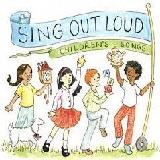 Sing Out Loud Children's Songs Sing Out Loud Children's Songs
Sing Out Loud Children's Songs includes popular children's songs in the U.S.A. Posters accompany the
individual Sing Out Loud Children's Songs. These
songs come with audio programs.
Great English listening and reading
practice. |
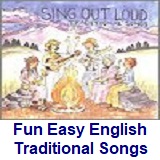 Sing Out Loud Traditional Songs Sing Out Loud Traditional Songs
The Sing Out Loud Traditional Songs
collection contains 13 traditional American folk songs and song lyrics.
Listen to the songs online, read the lyrics, and collect the posters that
accompany the songs. These
songs come with audio programs.
Great English listening and reading
practice. |
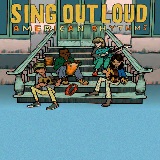 Sing Out Loud American Rhythms Sing Out Loud American Rhythms
Do you love music? Want to use it
to learn English? Check out the hip-hop inspired song "Peace" from Sing Out
Loud American Rhythms. American Rhythms includes a variety of musical genres
from many different artists in the U.S.A. These songs will appeal to teens
and young adults. These
songs come with audio programs.
Great English listening and reading
practice. |
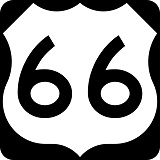 Route
66 - Famous American Road Route
66 - Famous American Road
U.S. Route 66 (US 66 or Route 66), also known as the Will Rogers Highway, the
Main Street of America or the Mother Road, was one of the original highways in
the U.S. Highway System. The highway, which became one of the most famous roads
in the United States, originally ran from Chicago, Illinois, through Missouri,
Kansas, Oklahoma, Texas, New Mexico, and Arizona before ending in Santa Monica,
California, near Los Angeles, covering a total of 2,448 miles (3,940 km). It was
recognized in popular culture by both the hit song "(Get Your Kicks on) Route
66" and the Route 66 television show in the 1960s. |
Route 66: The Highway That's the Best
(Beginner - Listening)
A video lesson which shows you an interesting place in America.
The English is
spoken at 75% of normal speed.
Great English listening practice.
This video shows travel along Route 66, the most famous road in
America. |
Chicago: The Start of Route 66
(Beginner - Listening)
A video lesson which shows you an interesting place in America.
The English is
spoken at 75% of normal speed.
Great English listening practice.
This video shows travel along Route 66, the most famous road in
America. |
Going West for Decades on Route 66
(Beginner - Listening)
A video lesson which shows you an interesting place in America.
The English is
spoken at 75% of normal speed.
Great English listening practice.
This video shows travel along Route 66, the most famous road in
America. |
Arizona: The Spirit of Route 66
(Beginner - Listening)
A video lesson which shows you an interesting place in America.
The English is
spoken at 75% of normal speed.
Great English listening practice.
This video shows travel along Route 66, the most famous road in
America. |
Route 66 California: The End of the Trail
(Beginner - Listening)
A video lesson which shows you an interesting place in America.
The English is
spoken at 75% of normal speed.
Great English listening practice.
This video shows travel along Route 66, the most famous road in
America. |
Ten Must-See Route 66 Attractions
(Beginner - Listening)
A video lesson which shows you an interesting place in America.
The English is
spoken at 75% of normal speed.
Great English listening practice.
This video shows travel along Route 66, the most famous road in
America. |
Four Famous Foods On Route 66
(Beginner - Listening)
A video lesson which shows you an interesting place in America.
The English is
spoken at 75% of normal speed.
Great English listening practice.
This video shows travel along Route 66, the most famous road in
America. |
International Tourists Drawn to Route 66
(Beginner - Listening)
A video lesson which shows you an interesting place in America.
The English is
spoken at 75% of normal speed.
Great English listening practice.
This video shows travel along Route 66, the most famous road in
America. |
|
|
|
|
Search Fun Easy English |
|
|
|
|
|
|
|
|
|
|
|
|
|
|
|
About
Contact
Copyright
Resources
Site Map |